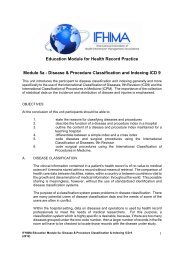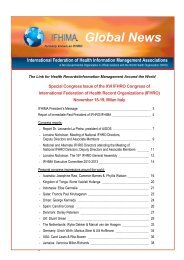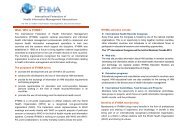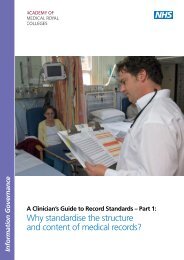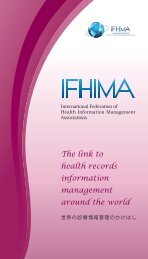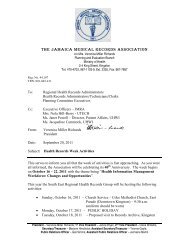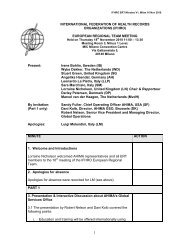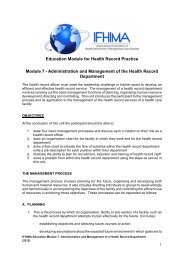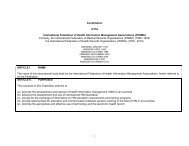Learning Packages for Medical Record Practice - ifhima
Learning Packages for Medical Record Practice - ifhima
Learning Packages for Medical Record Practice - ifhima
Create successful ePaper yourself
Turn your PDF publications into a flip-book with our unique Google optimized e-Paper software.
schedules. In that case, the department staff can determine the time of<br />
printing the requests.<br />
g) <strong>Record</strong> requests <strong>for</strong> research or <strong>for</strong> administrative purposes should be<br />
considered as routine requests.<br />
h) "Stat" requests are non-routine requests, that must be processed as<br />
quickly as possible, and include emergencies, ambulatory care without<br />
appointment, and urgent hospitalization.<br />
i) Urgent requests are usually made by phone or computer, and health<br />
record personnel are required to complete the requesting procedures<br />
immediately.<br />
j) The health in<strong>for</strong>mation management/health record professional should<br />
develop procedures in order to<br />
maintain complete control over incoming and outgoing records.<br />
2. Health record requests<br />
a) The requisition slip is usually a multi-copy <strong>for</strong>m or a computer generated<br />
<strong>for</strong>m, containing in<strong>for</strong>mation on the patient's name and record number,<br />
the destination (the person or area requesting the record), the date and<br />
other headings as necessary, such as the name or signature of the<br />
requesting party.<br />
b) One copy of the slip is attached to the record and another copy becomes<br />
the sign-out slip, which is placed in an outguide (or tracer) that replaces<br />
the requested record in the file. No record may be removed from the file<br />
without being replaced by an outguide (or tracer) with a requisition slip.<br />
This is the most important rule of record processing. A third copy can be<br />
placed in a separate file <strong>for</strong> reference. It may be in an alphabetic file by<br />
patient name, or in a "tickler" file, in chronological order of the sign-out<br />
date. This latter file gives an indication of all records that are not returned<br />
within the established period of time.<br />
c) If a computerized chart tracking system is used, outguides (or tracers) are<br />
not necessary. This process requires only that a request be sent, the<br />
record retrieved, and the record signed out as needed in the system.<br />
d) The health record department should be in<strong>for</strong>med when a record is<br />
moved from one area to another. This can be done by telephone, or<br />
better by using a transfer-slip, indicating patient's name and record<br />
number, date, previous and next destination. If a computerized system is<br />
used, only a phone call is needed and the chart’s location updated.<br />
3. Outguides (or tracers)<br />
Outguides (or tracers) replace a record that is removed from the files <strong>for</strong> any<br />
IFHIMA Education Module 3: <strong>Record</strong> Identification Systems, Filing and Retention of Health <strong>Record</strong>s<br />
(2012)<br />
19



